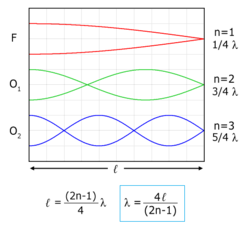- Overtone
-
"Overtones" redirects here. For other uses, see Overtones (disambiguation).
An overtone is any frequency higher than the fundamental frequency of a sound. The fundamental and the overtones together are called partials. Harmonics are partials whose frequencies are whole number multiples of the fundamental (including the fundamental which is 1 times itself.) These overlapping terms are variously used when discussing the acoustic behavior of musical instruments. Due to a translation error in its coining, Alexander J. Ellis strongly suggested avoiding the term overtone in deference to upper partial (simple) tones.[1] (See etymology below.)
 Vibrational modes of an ideal string, dividing the string length into integer divisions, producing harmonic partials f, 2f, 3f, 4f, etc. (where f means fundamental frequency).
Vibrational modes of an ideal string, dividing the string length into integer divisions, producing harmonic partials f, 2f, 3f, 4f, etc. (where f means fundamental frequency). main tone (110 Hz) and first 15 overtones (16 harmonic partials) (listen)
main tone (110 Hz) and first 15 overtones (16 harmonic partials) (listen)
When a resonant system such as a blown pipe or plucked string is excited, a number of overtones may be produced along with the fundamental tone. In simple cases, such as for most musical instruments, the frequencies of these tones are the same as (or close to) the harmonics. An example of an exception is a circular drum, whose first overtone is about 1.6 times its fundamental resonance frequency.[2] The human vocal tract is able to produce a highly variable structure of overtones, called formants, which define different vowels.
Contents
Explanation
Most oscillators, from a guitar string to a bell (or even the hydrogen atom or a periodic variable star) will naturally vibrate at a series of distinct frequencies known as normal modes. The lowest normal mode frequency is known as the fundamental frequency, while the higher frequencies are called overtones. Often, when an oscillator is excited by, for example, plucking a guitar string, it will oscillate at several of its modal frequencies at the same time. So when a note is played, this gives the sensation of hearing other frequencies (overtones) above the lowest frequency (the fundamental).
Timbre is the quality that gives the listener the ability to distinguish between the sound of different instruments. The timbre of an instrument is determined by which overtones it emphasizes. That is to say, the relative volumes of these overtones to each other determines the specific "flavor" or "color" of sound of that family of instruments. The intensity of each of these overtones is rarely constant for the duration of a note. Over time, different overtones may decay at different rates, causing the relative intensity of each overtone to rise or fall independent of the overall volume of the sound. A carefully trained ear can hear these changes even in a single note. This is why the timbre of a note may be perceived differently when played staccato or legato.
A driven non-linear oscillator, such as the human voice, a blown wind instrument, or a bowed violin string (but not a struck guitar string or bell) will oscillate in a periodic, non-sinusoidal manner. This generates the impression of sound at integer multiple frequencies of the fundamental known as harmonics. For most string instruments and other long and thin instruments such as a trombone or bassoon, the first few overtones are quite close to integer multiples of the fundamental frequency, producing an approximation to a harmonic series. Thus, in music, overtones are often called harmonics. Depending upon how the string is plucked or bowed, different overtones can be emphasized.
However, some overtones in some instruments may not be of a close integer multiplication of the fundamental frequency, thus causing a small dissonance. "High quality" instruments are usually built in such a manner that their individual notes do not create disharmonious overtones. In fact, the flared end of a brass instrument is not to make the instrument sound louder, but to correct for tube length “end effects” that would otherwise make the overtones significantly different from integer harmonics. This is illustrated by the following:
Consider a guitar string. Its idealized 1st overtone would be exactly twice its fundamental if its length was shortened by ½, say by lightly pressing a guitar string at the 12th fret. However, if a vibrating string is examined, it will be seen that the string does not vibrate flush to the bridge and nut, but has a small “dead length” of string at each end. This dead length actually varies from string to string, being more pronounced with thicker and/or stiffer strings. This means that halving the physical string length does not halve the actual string vibration length, and hence, the overtones will not be exact multiples of a fundamental frequency. The effect is so pronounced that properly set up guitars will angle the bridge such that the thinner strings will progressively have a length up to few millimeters shorter than the thicker strings. Not doing so would result in inharmonious chords made up of two or more strings. Similar considerations apply to tube instruments.
Musical usage term
An overtone is a partial (a "partial wave" or "constituent frequency") that can be either a harmonic partial (a harmonic) other than the fundamental, or an inharmonic partial. A harmonic frequency is an integer multiple of the fundamental frequency. An inharmonic frequency is a non-integer multiple of a fundamental frequency.
An example of harmonic overtones: (absolute harmony)
Frequency Order Name 1 Name 2 Name 3 1 · f = 440 Hz n = 1 fundamental tone 1st harmonic 1st partial 2 · f = 880 Hz n = 2 1st overtone 2nd harmonic 2nd partial 3 · f = 1320 Hz n = 3 2nd overtone 3rd harmonic 3rd partial 4 · f = 1760 Hz n = 4 3rd overtone 4th harmonic 4th partial Some musical instruments produce overtones that are slightly sharper or flatter than true harmonics. The sharpness or flatness of their overtones is one of the elements that contributes to their unique sound. This also has the effect of making their waveforms not perfectly periodic.
Musical instruments that can create notes of any desired duration and definite pitch have harmonic partials. A tuning fork, provided it is sounded with a mallet (or equivalent) that is reasonably soft, has a tone that consists very nearly of the fundamental, alone; it has a sinusoidal waveform. Nevertheless, music consisting of pure sinusoids was found to be unsatisfactory in the early 20th century.
Etymology
In Hermann von Helmholtz's classic "On The Sensations Of Tone" he used the German "Obertöne" which was actually a contraction of "Oberpartialtöne", or in English: "upper partial tones". However, due to the similarity of German "ober" to English "over", a Prof. Tyndall mistranslated Helmholtz' term, thus creating "overtone". This mistranslation creates unfortunate confusion, adding an additional term that is mathematically problematic (as described above) and has unfortunate mystical connotations that have led to the suggestion that if there are overtones, perhaps there are "undertones" (a term sometimes confused with "difference tones" but also used in speculation about a hypothetical "undertone series"). In contrast, the correct translation of "upper partial tones" does not have any problematic implications. Alexander Ellis discusses the mistranslation on pages 24–25 of his definitive English translation of Helmholtz, where Ellis strongly suggests avoidance of the term "overtone". [1]
"Overtones" in barbershop music
In barbershop music, the word overtone is often used in a related but particular manner. It refers to a psychoacoustic effect in which a listener hears an audible pitch that is higher than, and different from, the fundamentals of the four pitches being sung by the quartet. The barbershop singer's "overtone" is created by the interactions of the upper partial tones in each singer's note (and by sum and difference frequencies created by nonlinear interactions within the ear). Similar effects can be found in other a cappella polyphonic music such as the music of the Republic of Georgia and the Sardinian cantu a tenore.
String instruments
String instruments can also produce multiphonic tones when strings are divided in two pieces. The most developed instrument for playing multiphonic tones is the Sitar in which there are sympathetic strings which help to bring out the overtones while one is playing. The most well-known technique on a guitar is playing flageolet tones. The Ancient Chinese instrument the Guqin contains a scale based on the knotted positions of overtones. Also the Vietnamese Đàn bầu functions on flageolet tones. Other multiphonic extended techniques used are prepared piano, prepared guitar and 3rd bridge.
Overtone singing
Overtone singing, also called harmonic singing, occurs when the singer amplifies voluntarily two overtones in the sequence available given the fundamental tone he/she is singing. Overtone singing is a traditional form of singing in many parts of the Himalayas and Altay; Tibetans, Mongols and Tuvans are known for their overtone singing. In these contexts it is often referred to as throat singing, though it should not be confused with Inuit throat singing, which is produced by different means.
Jaw harp
A similar technique is used for playing the jaw harp: the performer amplifies the instrument's overtones by changing the shape, and therefore the resonance, of their vocal tract.
Free-reed aerophone
Likewise, when playing a harmonica or pitch pipe, one may alter the shape of their mouth to amplify specific overtones.
See also
- Harmonic series (music)
- Harmonics
- Just intonation
- Xenharmonic
- Stretched octave
- Combination tone
- Electronic tuner
- Scale of harmonics
References
- ^ a b Alexander J. Ellis (translating Hermann Helmholtz): On the Sensations of Tone as a Physiological Basis for the Theory of Music, pages 24 and 25. 1885, reprinted by Dover Publications, Inc., New York, 1954.
- ^ Elena Prestini, The Evolution of Applied Harmonic Analysis: Models of the Real World, ISBN 0817641254 (p140)
External links
Categories:
Wikimedia Foundation. 2010.

